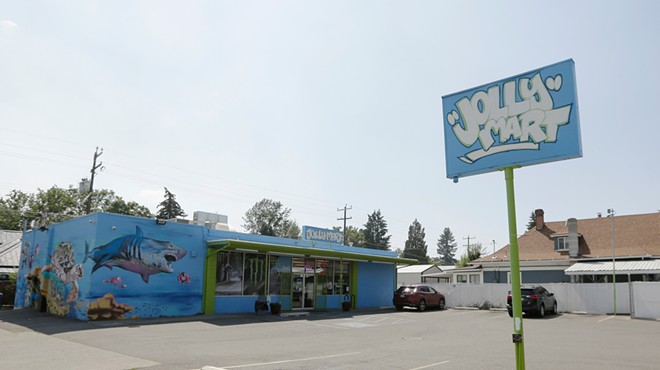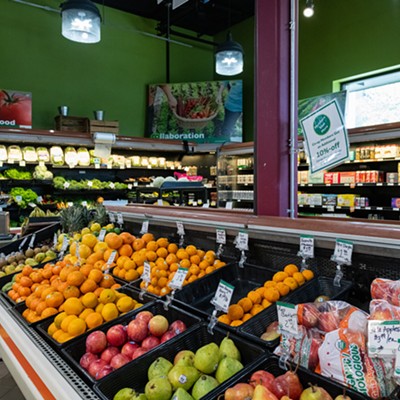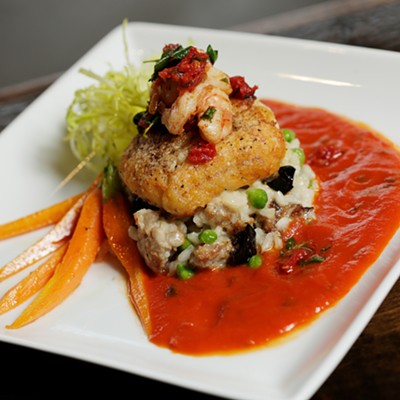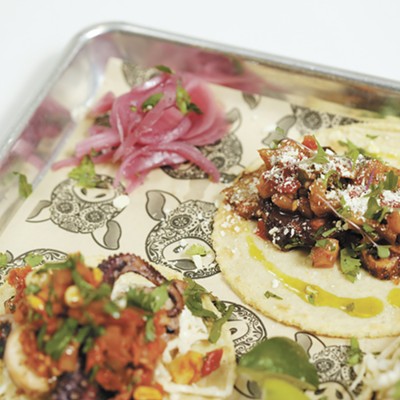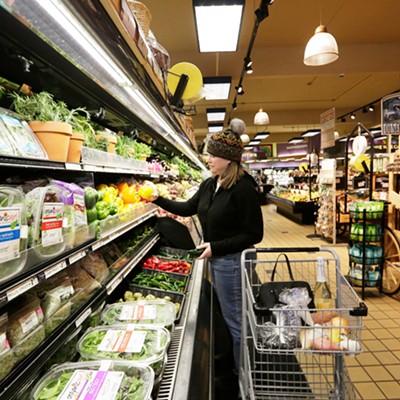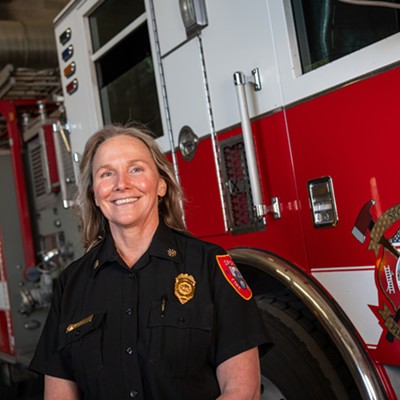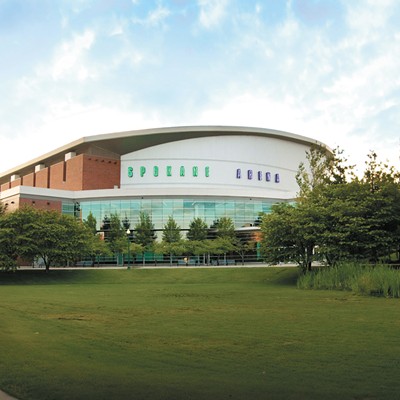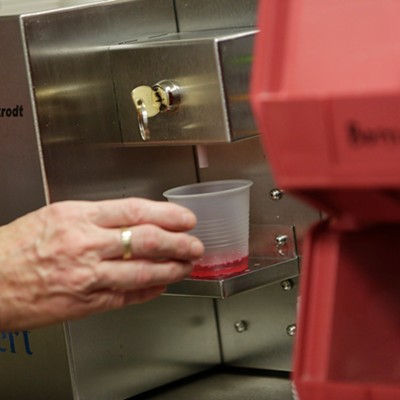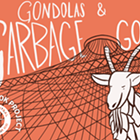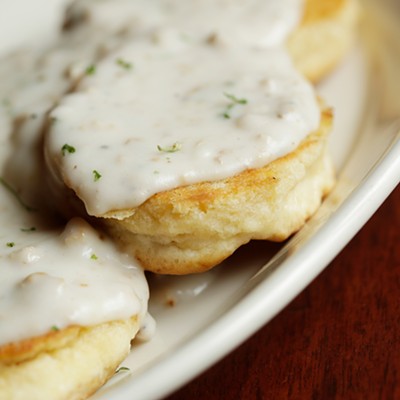
Second Harvest's mobile market delivery truck can carry 17,000 pounds of food. It's a lot, equivalent to the weight of an adult male elephant. On market days, doors on both sides of the truck open to reveal pallets stacked high with eggs, fruit, produce and other nutrient-dense food.
The food is nearly all donated by regional farms and producers and, prior to market day, stored inside Second Harvest's primary 80,000-square-foot Spokane warehouse.
Todd Kennedy, Second Harvest's mobile market coordinator, tries to match the food available to those who need it. So in addition to hamburger meat, apples, grapes, oranges, cereal, and seasonal vegetables like squash and potatoes, the mobile market includes enough boxes of cookies to generate smiles for young and old alike.
"I bring anything I think families can use," Kennedy says.
Getting food to hungry families has never been easy for food banks like Second Harvest, but the current climate makes the organizations' missions to feed the hungry more challenging. Food and transportation costs have increased. Food sourcing issues have too, including scarcity and longer lead times.
Data from the U.S. Department of Agriculture shows that the percentage of U.S. households experiencing food insecurity is roughly the same as before the pandemic. But Eric Williams, the director of community partnerships at Second Harvest, says his organization is seeing as much as a 45 percent increase in need.
Formed in 1971, Second Harvest Inland Northwest, as it's officially known, is the region's largest food resource center. It has roughly 250 member partners, mostly food banks connected to churches, schools, health care facilities or charitable organizations. Regardless of size, location or objective, most of them rely on donated or low-cost food to fill their shelves, including through programs like Bite2Go, which provides school-aged children in need with food for the weekend.
Second Harvest also distributes food to people directly through its mobile market program, which spans a 26-county area, from Boundary County in North Idaho to Benton County in south-central Washington.
At a Spokane mobile market earlier this month at West Central Community Center, the truck rolled up at 11:30 am — an hour-and-a-half before its opening time.
A dozen vehicles are already in queue. As Kennedy directs, volunteers get to work.
As one shovels ice, others set up canopies and tables sturdy enough to hold, if not the whole elephant, at least a portion of it. The mound of organic Yukon gold potatoes bagged for distribution grows to 2 feet. The smell of packaged oranges jostled onto the table suggests summer, even as the sky threatens flurries.
By noon the line has tripled, the end of it no longer visible.
When he first started with the mobile market seven years ago, says Kennedy, he'd see 120 to 160 families at an event.
"Back then, 240 families was a big event," he continues, adding that the truck is usually loaded in anticipation of 300 families. "There's a lot of new clients."
Most vehicles have Washington plates, but no one gets turned away.
"Other places ask for zip code or ID. Not here," Kennedy says. "You just roll up."
And roll they do. By 12:30, a half-hour before the market officially opens, it's go-time. Forty minutes later, 82 families have been through the line.
By 2 pm, it's up to 133 families, but the line is dwindling, so volunteers split off. Some consolidate food on the tables as others prepare boxes of food for pickup inside the community center after 3 pm when the mobile market officially ends.
Another half-hour passes, and 250 families have received roughly 60 pounds of food each, but there's a couple hundred pounds of food remaining, so Kennedy takes the rest to the Salvation Army.
By 3 pm, the truck's empty, and roughly 8 tons of food has been given away. The elephant is gone.
Food insecurity isn't a local or even regional problem. It's national. According to the USDA, more than 34 million people in the U.S. — 10 percent of all households — have experienced food insecurity yet do not qualify for federal food assistance and rely on food banks to get by.
"The worst thing you can do is run out of food," says Williams, who joined Second Harvest two years ago. "The second worst thing is to have food left over."
At the moment, Williams is more concerned about food scarcity than abundance.
"Food's been going out the door faster than it's coming in," Williams says.
In early November, Second Harvest spent $500,000 to shore up its supplies. Ordinarily, that would buy about 750,000 pounds of food, says Williams, adding that last month it only netted them roughly 500,000 pounds.
That still sounds like a lot, but when you're typically distributing about 92,000 pounds a week, it translates to around five weeks' worth instead of eight.
"It was necessary," Williams says. Also unsustainable.
It's not like Second Harvest wasn't aware of looming issues. Higher costs — of food, fuel, particularly diesel, and related labor — combined with reduced availability of items due to crop loss, staffing shortages and other factors have been part of the collective concern since 2020.
But unlike the consumer and even smaller food resource organizations, Second Harvest can't pull from Peter to feed Paul. Certain food is earmarked for certain programs. Food donated through the USDA or a Washington-based program can only be distributed to select recipients. For example, Bite2Go is only for schoolchildren.
So even though Second Harvest also launched a fundraiser to stock shelves through the end of December, it hasn't been enough to prevent more drastic measures. Second Harvest recently suspended food delivery to 80 of its 250 distribution partners through January 2023.
Many of these partners are in rural areas disproportionately impacted by food insecurity, according to Feeding America, a national organization affiliated with Second Harvest.
In its "Map the Meal Gap" report series, Feeding America notes that "nine out of 10 counties with the highest food insecurity rates are rural." And when "rural communities make up 63 percent of all U.S counties," including throughout the Inland Northwest, that's a big deal.
Bonner Community Food Bank is one such rural distribution partner impacted by the halted deliveries.
"We're feeling it greatly with our smaller communities around us," says Debbie Love, its executive director.
Ordinarily, they would get five pallets of food delivered every second Monday. The Second Harvest truck also brought food purchased by the food bank — at $5 per child — and designated for the Bite2Go program.
"We're grateful that that program is still available," says Love, who is working on renting a truck to pick up Bite2Go food for themselves, as well as for a Bonners Ferry food bank run by Community Action Partnership.
Love is also appreciative of the relationship with grocery stores that Second Harvest facilitated through its "grocery rescue" program for dairy, produce and other items that would otherwise go to waste, she says.
But Love is also preparing for the worst.
"We're not sure we'll see deliveries again in February," Love says.
VOLUNTEER, because that helps keep labor costs down
DONATE FOOD, especially shelf stable items like canned goods
DONATE MONEY (and enjoy a tax deduction)
SUPPORT your local food banks wherever possible
VISIT 2-HARVEST.ORG for more information, to donate, volunteer or find the food bank nearest you
In central and southern Idaho, the Idaho Foodbank is also facing challenges.
Centered in Meridian, Idaho, with branches in Lewiston and Pocatello, the Idaho Foodbank is comparable in size and structure to Second Harvest, providing roughly 27 million meals annually. It provides food through numerous programs including a mobile pantry and backpack program for schoolchildren, but over a larger area and correspondingly larger distribution network of 482 partners.
Idaho Foodbank relies on mostly donated food, including from manufacturers, distributors and growers, as well as from a grocery rescue program, according to Theresa Vawter, its spokesperson.
And the data from 2022 is quite different from a year prior. In its 2022 annual report, Idaho Foodbank noted a $5 million decrease in donated food value from the prior year, and a decrease in donated funds and food. Yet it also saw increased need. Just add food sourcing issues, and you have the perfect storm for any food resource center.
"The increased costs of food and transportation have certainly had an impact on our costs," Vawter said in an email. "Meat and protein are always in demand, and recently we have been more reliant on meat donations to reach our nutrition goals because of cost increases."
Scarcity of some items has also been a concern, Vawter says, including "kid-friendly and easy to open food" for Idaho Foodbank's backpack program.
But as 2022 winds down, Second Harvest's Williams says the issues affecting hunger aren't unique in Spokane, in Idaho or to the U.S. They're global.
"There are many international factors that are causing these problems," he says. "We have to watch those trends and be nimble." ♦

